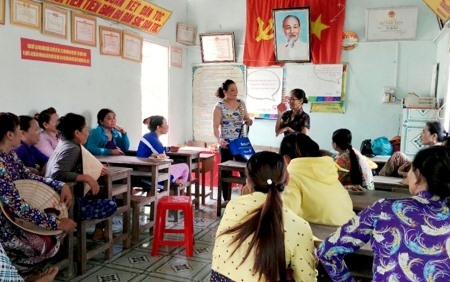 Society
Society

More than 1,470,000 people in 125 communes of three provinces have accessed reproductive health and family planning services during the past four years.
 |
| Women listen to consultancy on reproductive health in the southern province of Cà Mau as part of the project. — Photo baocamau.com.vn |
HÀ NỘI — More than 1,470,000 people in 125 communes of three provinces have accessed reproductive health and family planning services during the past four years.
Some 99.7 per cent of them are satisfied with the services, according to results of the third phase of the project on improving reproductive health of residents, run by Marie Stopes International in Việt Nam (MSV), in coordination with the provincial departments of health.
The results were declared on Wednesday in Hà Nội.
The project received financial support from Atlantic Philanthropies.
The third phase of the project, which began in 2013, was conducted in the northern province of Yên Bái, the Central Highlands province of Đắk Lắk and the southern province of Cà Mau.
The first phase, which began in 2007, was conducted in Khánh Hòa Province and Đà Nẵng City, while the second phase was conducted in Thái Nguyên, Thừa Thiên-Huế and Vĩnh Long provinces.
Further, under the third phase of the project, more than 2,000 commune medical workers received training on reproductive healthcare and providing family planning services.
Over 100 commune medical stations received an upgrade of infrastructure to set up consultancy rooms with the name “Tình Chị Em” (Sisterhood).
During the three periods, there were some 250 commune health stations set up across eight provinces around the country.
The model provides reproductive healthcare and family planning services, and delivers educational documents on the subject.
Nguyễn Thị Bích Hằng, head representative of MSV, said meeting the nation’s sexual reproductive health and family planning requirements remains a pressing issue for the State.
“This is especially in the case of vulnerable population groups, including rural and ethnic minority communities,” she said.
“Strengthening health service delivery at the community level is acknowledged as the key for improving the health of these groups,” she said.
Nguyễn Đức Vinh, director of the Maternal and Child Health Department under the Ministry of Health, said the “Tình Chị Em” model had developed solutions to improve the quality of services.
The model should be advocated, and awareness of the model should be improved at all levels, especially at policy-making levels, he said.
“For this purpose, all lesson learnt and documents should be widely shared within the donor community, creating potential opportunities for support to further pilot projects in the country,” he said.
The 90 million population of Việt Nam is predominantly young, with 58 per cent under 25, and includes many women of reproductive age - some 25 million - according to statistics of the MSV.
The national maternal mortality ratio of 67/100,000 births has remained relatively unchanged between 2006 and 2011. The infant mortality ratio stands at 15.5/1,000 births, statistics revealed.
The current national contraceptive prevalence rate of 79 per cent represents only use among married couples. — VNS




